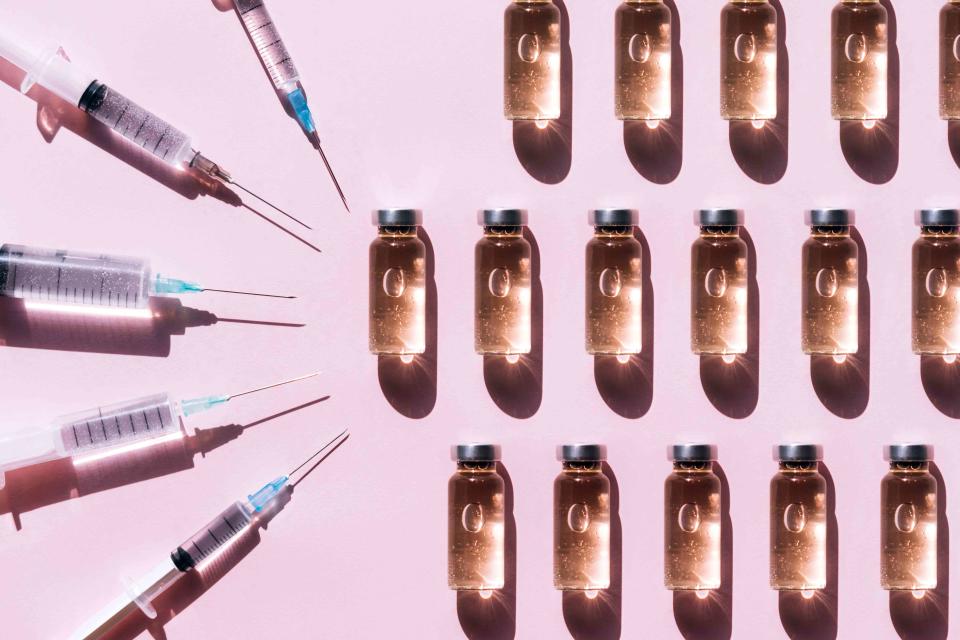Why Baby Botox Is TikTok's Favorite Aesthetic Treatment
Everything you need to know about this tweakment.

Getty Images
When done correctly, Botox can have many benefits for those who want smoother, more youthful-looking skin. But if the possibility of getting a "frozen" face still scares you — or if you're just a neuromodulator newbie — baby Botox might be the answer.
If you're extremely online, you may have already seen this treatment take over your FYP page — not to mention social media at large. While it's not exactly the most innovative development in the world of injectables, it's a technique worth considering if you're seeking a natural look. Consider this your crash course into baby Botox.
Related: Read This Before Getting Botox
What Is Baby Botox?
According to Dendy Engelman, MD, a board-certified dermatologist at the Shafer Clinic Fifth Avenue in New York City, baby Botox is a neuromodulator treatment, meaning it uses a neurotoxin that temporarily paralyzes the muscles beneath skin, effectively smoothing expression lines and wrinkles. (FYI: Neuromodulators are sold under the brand name Botox as well as Xeomin, Dysport, and Jeuveau — but often referred to as "Botox" as a shorthand). Also known as "micro Botox," it follows the same procedure as your typical injection, but deploys smaller doses.
"Since this is often used as a preventative measure, it’s great for someone who is just starting to see things like forehead lines, frown lines and crow’s feet, and wants to slow down their development," she says. "This tends to be people in their 20s who haven’t had treatments before."
Related: Botox vs. Fillers: Which Injectable Is Right for You?
It's also ideal for those who are looking for more subtle results, but have reservations about neuromodulators — as it's a quick, low-stakes procedure. "The term 'baby Botox' itself feels approachable," says Chelsie Rogers, PA-C, an Atlanta-based board-certified physician assistant and clinical lead at Skin Pharm.
Baby Botox vs. Regular Botox
The biggest difference between baby Botox and regular Botox is the dosage. "Baby Botox refers to a smaller dosage of Botox that’s injected to achieve a more natural, subtle outcome," says Rogers. "Regular Botox, on the other hand, typically involves a higher dosage for a more pronounced or 'frozen' effect."
Not only that, but because you're getting a smaller dose, the effects of baby Botox only last amount two to three months, says Dr. Engelman. (The standard dosage will typically last about four months, although it varies person to person.) So, it may be more high-maintenance, in that it requires more frequent treatments if you want ongoing results.
Related: Is Botox Worth the Hype? Here's How Long It Really Lasts
The Benefits of Baby Botox
Baby Botox has similar benefits to regular Botox, smoothing fine line and wrinkles in certain areas of the face. Where it differs is in its results. "It can yield a softer, more youthful look, particularly around the delicate eye area," says Rogers.
It can also help address future wrinkles. "Micro Botox is primarily used as a preventative method, while standard Botox is usually corrective," says Dr. Engelman. "It allows more muscle movement in the face post-injection than standard Botox."
Related: Is Preventative Botox a Scam? Dermatologists Weigh In
The Drawbacks of Baby Botox
The downsides are similar to regular Botox: You can expect the possibility of swelling and bruising afterwards, although that doesn't always happen. Dr. Engelman stresses the importance of going to a licensed and properly-trained injector so that there aren't any long-term effects.
What Happens During Baby Botox
The prep for baby Botox is fairly simple: Avoid taking blood thinning medication, drinking coffee, and using certain ingredients (like retinol) for about 24 hours before your treatment, says Dr. Engelman.
Similar to a regular Botox treatment, your practitioner will first consult with you about where you want it injected and assess the appropriate amount to give you your desired results. Then, they'll cleanse the treatment area with alcohol before injecting small superficial amounts into the top layer of the skin. A treatment can take anywhere from 20 minutes to an hour depending on what areas you want to be treated, says Dr. Engelman.
Generally, the aftercare and recovery time is simple for baby Botox. "After the injection, you can pretty much resume normal activities immediately," Dr. Engelman says. "It’s usually recommended with any neuromodulator procedure not to lie down for four to six hours, since it can potentially cause the material to migrate to other areas of the face or body." She also recommends you avoid rubbing your skin (so, cancel that facial), and to avoid sun exposure for the first few days.
Related: 6 Post-Botox Mistakes Way Too Many People Are Making
Finally, headaches may occur, so Rogers recommends taking an over-the-counter pain reliever like acetaminophen (e.g. Tylenol) to avoid further bruising.
How Much Baby Botox Costs
Because baby Botox requires a smaller dose, it's usually cheaper than the average neuromodulator treatment. But the price can depend on your location, your provider, and even the brand of neuromodulator you get. "It’s difficult to give an exact estimate since some clinics charge per unit while others charge for the area being treated," says Dr. Engelman. "That being said, you can expect baby Botox to be anywhere between $200 and $500."
Most patients get regular Botox two to three times a year, so expect to do the same with baby Botox when adding up the costs, Rogers says.
For more InStyle news, make sure to sign up for our newsletter!
Read the original article on InStyle.

